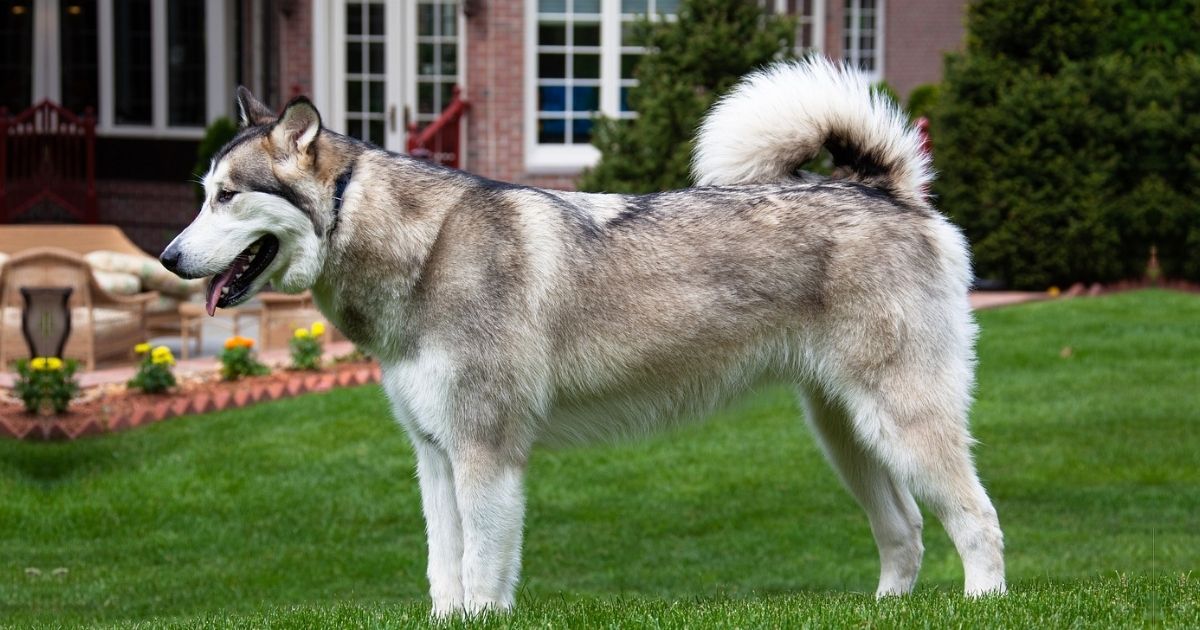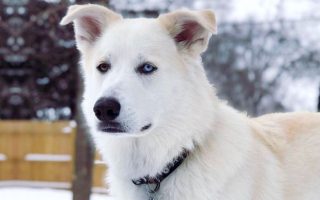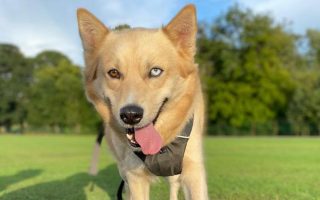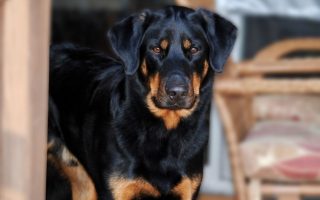The Alaskan Malamute is a big dog bred for work. With high energy and a dire need for companionship, they can be a handful, especially for the inexperienced.
Nevertheless, they bring joy and love to whatever home they step into.
They began their canine journey on earth pulling sleds. Now, they tug at the hearts of owners and strangers.
To own and train an Alaskan Malamute, there are needs you should meet if you want your time with this breed to be productive
The right environment, personality, time, and commitment are just a few factors that can make or mar thoughts of getting an Alaskan Malamute. Of course, it isn’t a journey for everyone.
If you already have an Alaskan Malamute, we applaud your efforts and hope you will get further tips to strengthen the bond between you and your pet.
If you don’t have one yet and you want to know if the Malamute is worth the cost, you will get to find out if this furry is the right dog for you.
This article uncovers all you need to know about the Alaskan Malamute facts, dog breed information, characteristics, behavior, temperament, health, care needs, training, and more.

Alaskan Malamute Facts & Dog Breed Information
| Dog Breed Group | Working dogs |
| Height | 1 ft 11 inches to 2 ft 1 inch |
| Weight | 75 to 100 pounds |
| Coat | Thick, double, a plush undercoat |
| Color(s) | Gray, black, white, sable |
| Life Expectancy | 12 – 15 years |
| Temperament | Friendly, Quiet, Playful, Loyal |
| Origin | United States |
| Bred For | Sledding |
| Nickname(s) /Other Name(s) | The Fat Husky |
| Recognized by the AKC, UKC, ANKC, CKC | Yes |
Alaskan Malamute Characteristics
| Characteristics | Rating |
|---|---|
| Adaptability | 2/5 |
| Friendliness | 4/5 |
| Kid-Friendly | 3/5 |
| Pet-Friendly | 3/5 |
| General Health | 4/5 |
| Grooming Needs | 4/5 |
| Trainability | 4/5 |
| Intelligence | 4/5 |
| Playfulness | 4/5 |
| Exercise Needs | 4/5 |
| Energy Level | 4/5 |
| Tendency to Bark | 3/5 |
| Tendency to Drool | 2/5 |
| Tendency to Snore | 1/5 |
| Tendency to Dig | 4/5 |
Interesting facts about the Alaskan Malamute dog breed
Fact #1: The Alaskan Malamute is Alaska’s state dog
While there are other breeds that originated from Alaska (Like the Alaskan Husky, for instance) the Malamute has been Alaska’s state dog for years.
They got this honor in 2010 thanks to some students’ efforts.
The students came from Anchorage and, following one of their desires for Alaska to have a pet dog, went into action.
It turned into a project as they made research and phone calls. The students picked the Malamute because of his long existence. Their work paid off in May 2010.
Fact #2: They’ve been around for some millennia
Drawing from what was said about long existence, the Malamute is an old dog.
According to research, they have existed for 5,000 years. That’s a lot of civilization come and gone.
Their ancestors came from Siberia to Alaska with natives like the Mahlemut tribe.
Fact #3: They participated in both World Wars
Because of their size, strength, and intelligence, Malamutes played major roles in both World Wars.
In the First World War, they delivered supplies to French soldiers in mountainous areas.
Years later, they came on the battlefield once more. In the Second World War, they located mines, rescued injured soldiers, and transported weapons.
Fact #4: The Alaskan Malamute is a pack dog
Not a fan of isolation, the Malamute wants to be around humans and love companionship.
It is vital you fill this need, or they’d get bored and anxious when alone.
If you have a busy schedule but want to get a Malamute, make arrangements for a dog sitter.
Fact #5: They were bred to sled
Alaskan Malamutes, like Huskies, pulled sleds along with the snow. They didn’t participate in sled races much because other sled dogs are faster.
However, what Malamutes lack in speed, they make up for in size.
They were charged with pulling heavy loads, a task only they could execute with ease.
Breed History & Origin
The Alaskan Malamute originated from Alaska, United States, and was made the state dog in 2010.
They came with the size and stamina to be sledders, pulling heavy loads along long distances.
They were also hunters, going after big prey like bears and tracking down seals.
The Alaskan Malamute has existed for an estimated 5,000 years. They were one of the first dogs in Alaska.
The Malamute’s ancestors were introduced into America by natives who treated these dogs well.
The Mahlemut tribe’s settlement in the Seward Peninsula became the home of the Alaskan Malamute as we know it today.
In 1986, during the gold rush, many dogs came into Alaska to assist miners, including the Malamute.
A lot of cross-breeding happened during this period and pure breeds were lost.
However, the Alaskan Malamute remained intact thanks to the Mahlemut. Today, they remain a breed that has gone through few changes.
This breed has played a lot of popular roles in history. When Admiral Richard Bryd went to the South Pole, a Malamute accompanied him.
During the 1986 gold rush, they were there. In the First World War, they delivered supplies to French soldiers.
In the Second World War, they were more instrumental by participating in search and rescue operations, carrying weapons, and detecting mines.
Sadly, their participation in the war affected their numbers.
In 1935, the Alaskan Malamute Club of America came to be. That same year, the American Kennel Club recognized the breed and set a standard.
Alaskan Malamute Temperament, Behavior & Intelligence
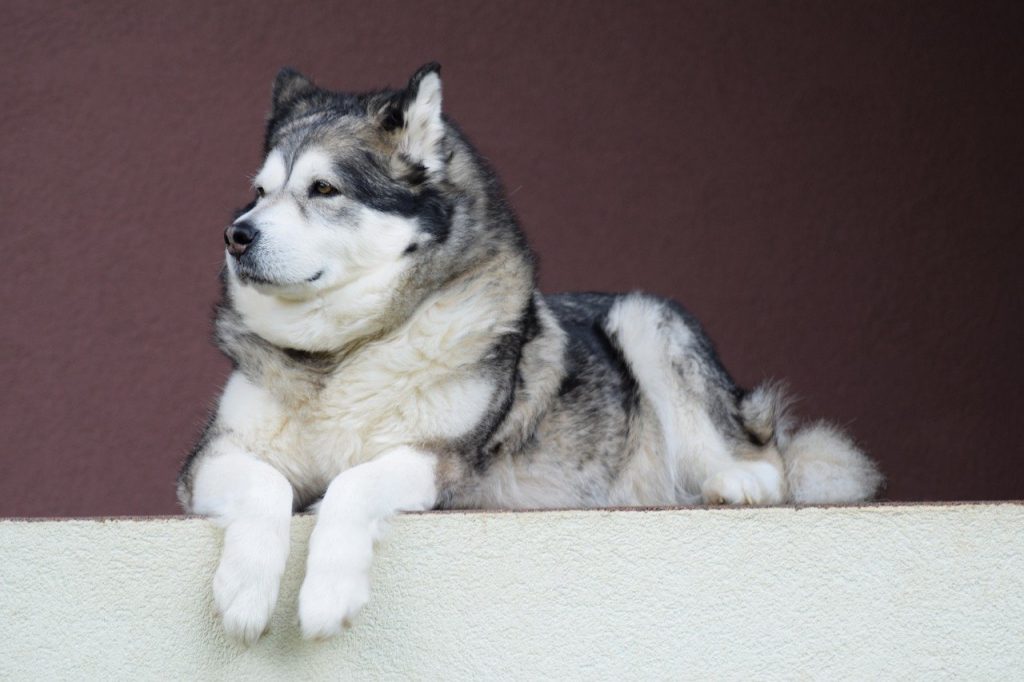
If you visit a home with a Malamute, you may be intimidated by his size and imposing frame, until he gives you a warm welcome that contrasts your first impression.
This breed has a big heart that accommodates everybody, including strangers. If you like friendly dogs who won’t pose a threat to visitors, you’ll love the Malamute.
They don’t make good watchdogs or guard dogs, though. They neither have the ferocity nor the barking tendencies.
Malamutes have a lot of energy to spare, a trait that makes them unfit for apartment life. They are also quite sensitive and should be handled with caution.
They love being around people and thrive with human companionship. This is not a dog you should leave alone for long. You shouldn’t leave the Malamute bored either.
They are workers who want activities and challenges to keep them occupied.
While their playfulness and fondness for people make them lovely pets, they can be quite bossy and independent.
For a breed that has been in wars and dragged heavy loads across freezing climates, this shouldn’t be a surprise.
It does make them daunting for someone who doesn’t know much about dog behavior. The new dog owner is not advised to get a Malamute.
Overall, the Malamute is a highly energetic, extroverted, friendly, and fun-loving breed.
He loves the outdoors and would often be seen digging holes in the yard, a habit that’s almost impossible to get rid of.
With the right owner, environment, and lifestyle, you’d never be bored with the Malamute.
Are Alaskan malamutes good family dogs?
Malamutes are playful, friendly, and loyal to family members. As workers, they put their strength to good use. As family dogs, they never run short of affection and fun.
Boredom is an enemy of the Malamute, so be prepared to live an interesting life when you have a Malamute pet. They are always up and about. Be sure you’re fit for their frantic nature.
Also, they are not suitable for people who want a guard dog or watchdog. While their size may make you feel they qualify, they are more likely to befriend a stranger than ward them off with barks and growls.
New owners would have a problem dealing with the Malamute, as well. With their independent nature, intelligence, sensitivity, and bossy streak, only an experienced dog owner can harness the good qualities of the Malamute.
Are Alaskan Malamutes good with kids?
Alaskan Malamutes are patient dogs, playful with adults as they are with children. They love the fun and energy of children and can deal with some rough play.
In fact, they once were considered babysitters because of their fondness for young ones. However, their energy and size may prove too daunting for a little child.
Accidents may occur if you leave a 5-year-old with a Malamute. It is ideal for this breed to be in a family with older kids who can handle the energy.
Teach your children how to interact and respect dogs, even before you get one. Also, don’t leave your Malamute with a child unsupervised.
Are Alaskan Malamutes good with other dogs and pets?
With proper training, the Malamute can get along with other dogs. They don’t get territorial and can share their space with another canine, especially the one they were raised with.
Extra socialization is needed with other pets like cats, so the Malamute will not consider them as prey. In the early stages, supervise whatever encounter they have with other pets.
Male vs Female Alaskan Malamute

The Malamute genders have some differences that set them apart and can influence one’s decision.
To begin with, the Malamute male is larger than the female with a 10 pounds difference.
While the male Malamute weighs 85 pounds, the female Malamute is at 75. The male is also taller by 2 inches.
The next distinction is in their genitals. As with other breeds, the male genitals are external and can be seen if you flip your dog over.
The female also has reproductive quality, which is an advantage if you want little Malamute puppies to breed. The unspayed female Malamute gets two heat cycles yearly.
This is also known as the estrus stage when the female dog is ready to conceive. The male and female Malamute share similarities in their personalities in that they are both friendly, playful, and energetic.
The males tend to be more territorial, however, while the females are sometimes more vicious with other dogs.
Should you get a male or female Malamute? Ultimately, the decision is yours.
Taking into account your lifestyle, personality, personal preference, and environment choose whatever is right for you.
Caring for an Alaskan Malamute
Because of their size and energy, Alaskan Malamutes are not good indoor animals. They desire a yard they can play around in.
However, this doesn’t mean they cope with solitude. It is not advisable to leave your Malamute alone.
Malamutes are diggers, a habit you may find difficult to break. The best thing to do is give them space in the yard where they can indulge in their favorite pastime.
Do make sure your fence is dug in to prevent them from escaping underneath. Malamutes have a strong prey sense and should not be left to wander. If they figure out that they can dig and be ‘free’, they will.
They were bred to be workers. Thus, they like to keep busy. Malamute isn’t that dog who would sleep throughout the day or remain inactive indoors.
If you’re someone who prefers the indoors, the Malamute isn’t for you. Left bored and idle, the Malamute will find ways to keep himself busy. You will not like the result. So, give him adequate exercise.
Malamutes are trainable, but that doesn’t mean it is easy. They combine tough features like intelligence, stubbornness, and strength.
Though they don’t have aggressive tendencies, they can be willful and may not want to do things your way.
Without firmness from your part, they’d want to take over and run your household, a situation that should never be permitted.
They also need to be fed the right nutrients and ration. Also, regular checkups with the vet will facilitate early diagnosis and help keep them healthy.
They also need to be clean and brushed, particularly during shedding season.
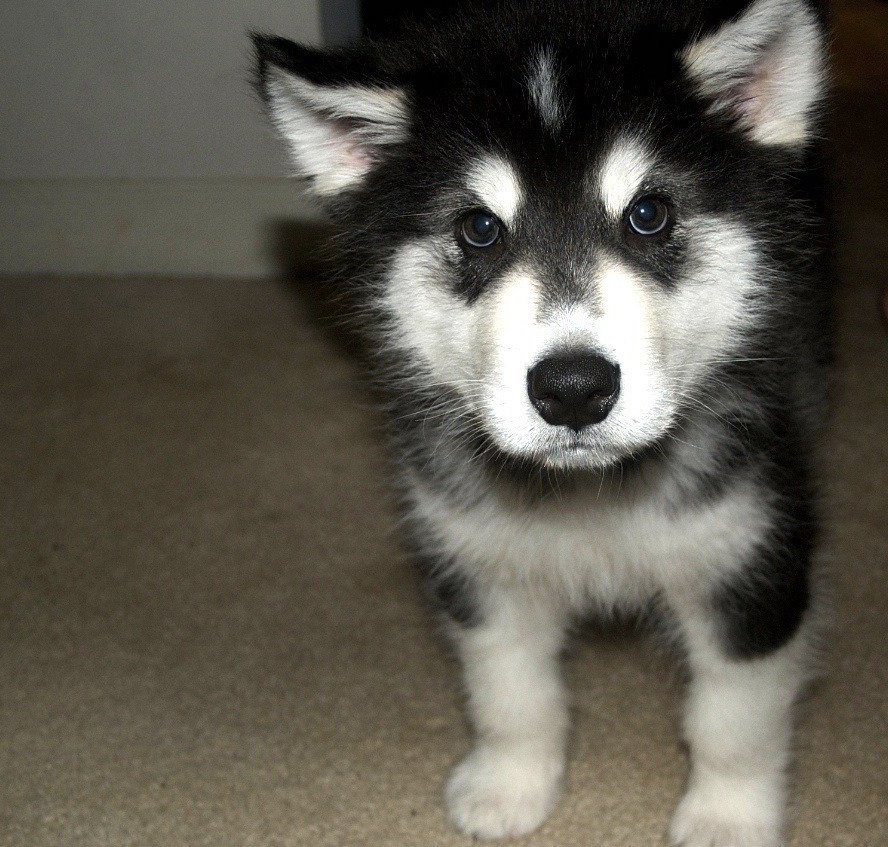
Alaskan Malamute Food and Diet
Food is essential for your Malamute’s well-being. As large, energetic dogs, they need food that fits their size and nature.
With the right nutrients served the right way, your dog will remain strong and in good form.
Giving the Malamute a poor diet can be detrimental to him. You can’t afford to the reckless or ignorant about this.
While some nutrients will do a Malamute some good, others should be avoided for their safety.
What we offer is a general feeding guideline on the Malamute and may not cover every individual dog’s needs.
While you should take what you read here as legitimate, know your Malamute and figure out his feeding needs. For better information, consult a veterinarian, breeder, or nutritionist.
A Malamute puppy should be given neither human food nor adult meal as both can be damaging to his development.
What puppies need is high-quality puppy food that would give them the nutrients they need to grow. You can start by feeding your puppy 4 small meals a day, then reduce as he grows older.
When the Malamute becomes an adult, less is required. You can feed them twice a day. Avoid free feeding as this breed tends to overeat and knows no boundaries when it comes to food.
Seniors don’t move around as much as puppies and adults. So, too much food puts them at risk of gaining weight. They also tend to eat slower.
Alaskan Malamute Exercise
We’ve already established that the Alaskan Malamute is an energetic breed. Exercise is compulsory for them.
They need a high amount of exercise, at least one or two hours of intense activities. Exercise has to be a lifestyle for you before you consider this breed.
Exercise should not be just physical activities though. As much as the Malamute is a strong worker, he also has the brains to match the brawn. Let exercise be a mix of physical and mental activities.
Puppy Malamutes should avoid any exercise that’s too intense. They are growing and delicate, so any intense exercise like walks and jogs will be too much for them.
A convenient way to exercise your puppy is to give him toys to play with.
When the Malamute becomes an adult, that’s when you increase the exercise level to fit his high energy.
Brisk walks and jogs are great activities that can let him bring out that energy.
Do note that the Malamute is best suited for a cold climate. Exercising them under the sun can lead to issues like heatstroke.
Take extra precautions during this period for the safety of your Malamute.
Besides daily walks and jogs, there are other activities that can keep your dog active and happy. Some of them are:
- Fetch
- Frisbee Toss
- Tug of war
- Pulling weight
As for senior Malamutes, exercise keeps them balanced and prevents some age-specific conditions like arthritis.
They don’t need as much exercise as younger Malamutes but find ways to keep them busy.
Training an Alaskan Malamute is a task, one that isn’t easy. This is why the Malamute needs an owner who understands how dogs behave.
Their intelligence, size, and stubbornness make them unsuitable for newbies.
Like many sled dogs, Malamutes know how to think on their own. They got used to it during their sledding and hunting days.
Don’t imagine this trait will vanish with a poof. While appreciating their independence as a good trait, let it not hinder training.
Start training your Malamute as a puppy when his size is manageable enough. It is at this point you put yourself as the alpha leader.
The Malamute is a pack animal, so if he doesn’t see you as a leader, he’d want to take over.
Obedience training is a must with the Malamute. There should be routines your dog can learn and get used to.
For example, have some specific times to feed him. That way, he’d know exactly when to expect his meal.
Teach him some basic commands too.
Also, though the Malamute is friendly, socialization is necessary, especially if you want a house with multiple dogs and pets.
Take them to dog parks to get them acquainted with other dogs.
Teach them that pets aren’t prey so they won’t hunt down your hamster or chase after your cat.
With consistency, positive reinforcement, and other training skills, training a Malamute is achievable.
Alaskan Malamute Grooming Needs
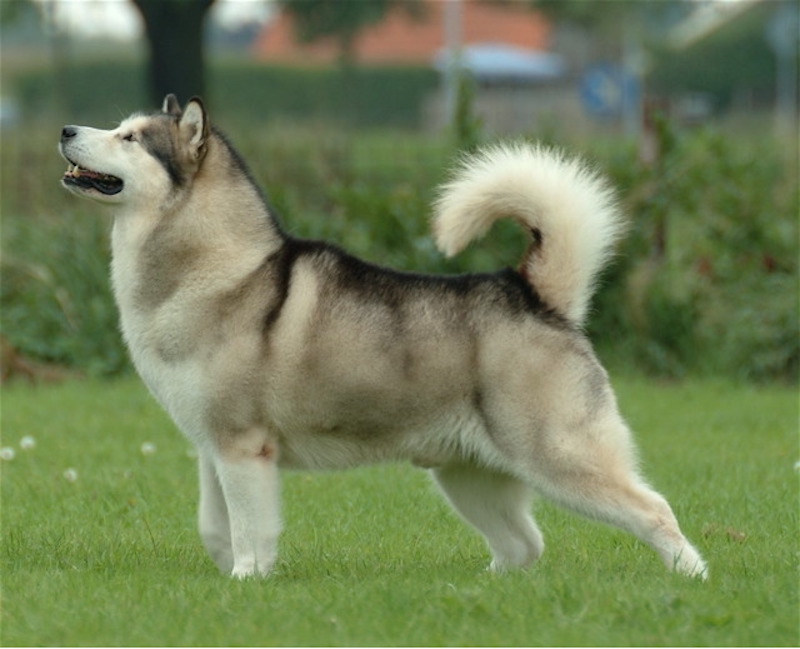
Like cats, Alaskan Malamutes tend to clean up after themselves. Their coat doesn’t develop an odor, a plus for owners who wouldn’t have to deal with constant bathing.
In fact, bathing should be kept at a minimum. Once or twice a year is often enough, and that’s when they get messy.
Grooming becomes a bit tasking, though, during their shedding seasons. Arm yourself with a vacuum cleaner and brush during this period.
You’d need to brush them regularly and rid your house of all the fur.
Dental care shouldn’t be neglected, too. Get a vet-approved toothpaste and toothbrush.
With it, take care of their teeth. This prevents toothache, tooth decay, and other complications.
The next part to take care of is their ears. Malamutes have long ears that need to be cleaned out. Use a cotton ball and an approved ear cleaner only.
Don’t use any other object to clean their ears as that can lead to injury. Dogs with long or pointed ears are prone to infection, so be on the lookout for that.
Trim their nails too before they get long and uncomfortable. It is a bad sign if you can hear the nails clicking on the floor.
Be sure you have some experience trimming nails before you do so. If not, hire an expert.
If you come across any unusual signs on your dog as your groom, don’t hesitate to take him to the veterinarian. Bad signs include sores, bad odor, and red eyes.
Alaskan Malamute Health Conditions
Malamutes have survived so long, an indication of their good health. They have a long life span and are not known to drag their owners to the vet on a regular basis.
However, they do have medical issues to look out for. While it isn’t a must that all Malamutes get these illnesses, knowing them would go a long way.
Some of these health conditions are detailed below:
Cataract
Cataract affects the Malamute’s eyes and can lead to blindness if left untreated.
You’d know your dog has cataract if you notice a white, cloudy substance growing on the lens. While it can’t be prevented, it can be treated through surgery.
Hip dysplasia
Hip dysplasia is an inherited condition that happens when the joint gets loose.
You’d know your dog has hip dysplasia when you notice abnormal movement, a reluctance to move, and signs of pain.
You can prevent it by getting a puppy with a hip dysplasia-free record. Treatments for this condition include physical therapy and weight control.
Chondrodysplasia
This is a genetic disorder present in puppies at birth. It deforms their limbs and gives them an abnormal stance.
It is a condition present in humans as well. Chondrodysplasia has no treatment, but it can be detected with a screening test.
Frequently Asked Questions
What are Alaskan Malamutes known for?
Alaskan Malamutes were bred to be workers. They started out as sled dogs known for pulling heavy loads through a long-distance.
They were also hunters who participated in events like the world wars and the gold rush of 1986. Lastly, the Malamute is the state dog of Alaska.
How big do Alaskan Malamute get?
Alaskan Malamutes are big dogs whose size and imposing looks can scare off an intruder. When fully grown, they weigh up to 100 pounds and grow as tall as 2 ft 1 inch.
Do Malamutes like hugs?
Malamutes do like their owners and are friendly towards everyone, but they don’t appreciate hugs. They are not good options for those who want pets they can cuddle.
Is it hard to care for Alaskan Malamute?
Alaskan Malamutes have their pros and cons. As a pet owner, know about them and check if they are suitable for you. However, it isn’t hard to take care of a Malamute if you know what you’re doing.
How Long do Alaskan Malamutes live for?
Malamutes have the potential to live long and they stay healthy when well taken care of. They have a life span of 12 to 15 years.
How much do Malamutes cost?
Alaskan Malamutes are not cheap, but worth it if you have the means. A Malamute puppy costs between $1,200 and $2,000, depending on the pedigree. Some go as high as $3,000.
Do Alaskan Malamutes shed?
Alaskan Malamutes have a double coat that sheds a lot during some seasons. They require more grooming during those periods.
Are male or female Malamutes better?
Both genders make really good dogs and house pets. However, the decision to choose a male or female Malamute is ultimately yours. Do consider your lifestyle, personality, personal preference, and environment to choose the right dog for you.
Is an Alaskan Malamute right for you?
The Malamute is a strong, loyal and devoted companion who loves the outdoors and enjoys meeting people. Far from being antagonistic, they are friendly with everyone.
Expect to have a lot of fun moments and outside activities. However, you should be sure you can handle the Malamute before getting one.
They have their challenges like size, energy, stubbornness, and shedding. If you can deal with that, then the Malamute is right for you.
Final Thoughts
Hopefully, you found this article on Alaskan Malamute dog breed facts and information helpful.
Whether or not you should have a Malamute depends on you. Your purse, lifestyle, personality, preference, and experience all come into play to make a decision.
If you don’t feel you can handle a Malamute, there are many other options for you. With time, you’d find a perfect pet for you.
Check out this Complete Alphabetical List of Dog Breeds.
But If you can handle a Malamute, then take the bold step.
Also, consider adoption from a dog shelter. Not only is it more affordable, but you also give a Malamute a home.
Helpful Resources
- Official Profiles: Alaskan Malamute dog breed information:

